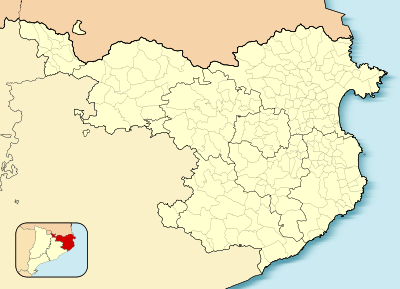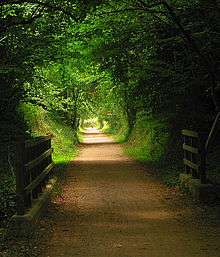Olot
| Olot | |||
|---|---|---|---|
| Municipality | |||
|
The Plaça Major of Olot | |||
| |||
|
Nickname(s): La ciutat dels volcans (The city of the volcanoes) | |||
 Olot  Olot Location in Catalonia | |||
| Coordinates: 42°11′N 2°29′E / 42.183°N 2.483°E | |||
| Country | Spain | ||
| Community | Catalonia | ||
| Province | Girona | ||
| Comarca | Garrotxa | ||
| Government | |||
| • Mayor | Josep Maria Corominas Barnadas (2015)[1] (CiU) | ||
| Area[2] | |||
| • Total | 29.0 km2 (11.2 sq mi) | ||
| Elevation | 443 m (1,453 ft) | ||
| Population (2015)[1] | |||
| • Total | 33,944 | ||
| • Density | 1,200/km2 (3,000/sq mi) | ||
| Website |
www | ||
Olot (Catalan pronunciation: [uˈɫɔt]) is the capital city of the comarca of Garrotxa, in the Province of Girona, Catalonia, Spain. The city is known for its natural landscape, including four volcanoes scattered around the city center. The municipality is part of the Garrotxa Volcanic Zone Natural Park. Olot is also well-known for its cultural activity, with historical art movements like Olot school or imaginery schools, which contributed to the location in the city of the main Design and Arts & Crafts school of the province of Girona, the Escola d'Art i Superior de Disseny d'Olot.
Etymology
The etymology of Olot is not clear and there are several hypotheses. According to the Crònica Universal de Catalunya, Olot was founded by Ulo, former king of the dynasty of Atlanteans, (then called Siculus), with the name of Ulot.[3] Another theory, more spread, is that the name comes from ala (wing in Catalan), because the city has been documented with the names Aulot and Alot. For this reason, the coat of Olot has a wing in reference to the name of the city.[3]
Situation
The municipality 29,12 km2 and includes the city of Olot and the town of Batet de la Serra (annexed in 1971). The term is located at 443.4 meters above sea level and is approximately 50 km from Girona, the capital of the province of the same name. It is bordered by Sant Joan les Fonts (north east), Santa Pau (south east), Les Preses (south west), Riudaura (west) and La Vall de Bianya (north west).
The municipality consist of the original city of Olot and old towns and neighbourhoods that now form a conurbation around the city (Sant Roc d'Olot, Sant Cristòfol de les Fonts, Sant Andreu del Coll, Closells) apart from different urbanisations (les Fonts, Mas Bernat, les Planoles, etc.) and the old municipality of Batet de la Serra, which was independent until 1971.

Geography and climate
Olot is located on a plain surrounded by the mountain ranges of Valentí, Aiguanegra, the plateau of Batet, Marboleny and Sant Valentí de la Pinya. The plain is crossed by the Fluvià river and the Riudaura stream. There are four volcanoes in the city of Olot, called Montolivet, Montsacopa, Garrinada and Bisaroques.
The Fluvià discharges 1.07 m3/s into the Mediterranean Sea.
The area of Garrotxa is generally more humid than neighbouring regions. The annual rainfall is around 1000 mm. Popularly, it is said that "if it isn't raining in Olot, it isn't raining anywhere" (Si no plou a Olot, no plou enlloc in Catalan). The minimum in Olot in January is around 0 °C, and the maximum in August is around 28 °C.
Population
| Population census | ||||||||||||||||||||||||||||||||||||||||||||||||||||||||||||||||||||||||||||||||||||||||||||||||||||
|---|---|---|---|---|---|---|---|---|---|---|---|---|---|---|---|---|---|---|---|---|---|---|---|---|---|---|---|---|---|---|---|---|---|---|---|---|---|---|---|---|---|---|---|---|---|---|---|---|---|---|---|---|---|---|---|---|---|---|---|---|---|---|---|---|---|---|---|---|---|---|---|---|---|---|---|---|---|---|---|---|---|---|---|---|---|---|---|---|---|---|---|---|---|---|---|---|---|---|---|---|
|
|
|
|
| ||||||||||||||||||||||||||||||||||||||||||||||||||||||||||||||||||||||||||||||||||||||||||||||||
| Source: IDESCAT | ||||||||||||||||||||||||||||||||||||||||||||||||||||||||||||||||||||||||||||||||||||||||||||||||||||
Main sights
.jpg)
The Montsacopa volcano is one of the main symbols of Olot. It has a cone of volcanic material and a circular crater. From above, a 360º panoramic of the city can be seen. The volcano also has a chapel on its top, dedicated to Saint Francis, and two watchtowers surrounding the crater. The old town, which grew up in the 9th century, has a rich cultural heritage, including the three-storied neo-classical cloister from the Hospici (charity building), the church of la Mare de Déu del Tura (patron of Olot), the Renaissance cloister of El Carme (which is a site of National Cultural Interest), and the Sant Esteve Parish Church, which was built in 1763 and it contains several artistic treasures, including an original El Greco (Christ carrying the Cross). Also in the old town there are examples of Art Nouveau architecture, like the Solà-Morales house.


Olot is a city of artists. Painting, sculpture and ceramics have been the key elements in the art of Olot, not to mention the tradition of the Nativity Scenes (pessebres), and the worldwide famous sculptures of saints. Also of importance is the School of Art, which was created in 1783 and nowadays it is the most important school of arts in the province of Girona (Escola d'Art i Superior de Disseny d'Olot). The artistic tradition of the city can be seen in several museums, being the Museu Comarcal de la Garrotxa the most relevant.

In Olot there are two important natural areas, the Moixina and the Parc Nou, which are characterized by their oak woods, which boast an undestorey of plants that are extremely rare on the south side of the Pyrenees. These woods also inspired many of the painters from the "Olot school". With the city being situated in the Garrotxa Volcanic Zone Natural Park, the surrounding area also offers spectacular natural places like the Fageda d'en Jordà (a beech forest with volcanic blisters) or the natural springs of Sant Roc. The city also has a bicycle lane connecting to Girona, which was an old railway.
Olot is also well-known for its local gastronomy. Its main products are the sweet herbal liquor ratafia, the traditional cakes coca de llardons and tortell de matafaluga, the charcuterie from Olot, the Olot potatoes (wafers of potato stuffed with meat, covered in egg and flour, and then deep-fried), and the buckwheat flour. Some of the restaurants of the city have grouped together, offering the so-called "volcanic cuisine". From these restaurants is worth to mention Les Cols, which has two Michelin stars.
Famous people from Olot
- Miquel Blay
- Jaume Bofill
- Josep Clarà
- Antonio Soler
- Marià Vayreda
- Pedro Llosas Badía
- Francesc Xavier de Bolòs i Germà
- Joaquim Danés i Torras
- Pau Estorch i Siqués
- Joan Pere Fontanella
- Manuel Malagrida i Fontanet
- Joaquim Masmitjà i de Puig
- Francesc Montsalvatge i Fosas
- Camil Mulleras i Garrós
- Esteve Paluzie i Cantalozella
Twin towns
- Notre-Dame-de-Bondeville, France
- Thuir, France
References
- Panareda Clopés, Josep Maria; Rios Calvet, Jaume; Rabella Vives, Josep Maria (1989). Guia de Catalunya, Barcelona: Caixa de Catalunya. ISBN 84-87135-01-3 (Spanish). ISBN 84-87135-02-1 (Catalan).
- 1 2 "Ajuntament d'Olot". Generalitat of Catalonia. Retrieved 2015-11-13.
- ↑ "El municipi en xifres: Olot". Statistical Institute of Catalonia. Retrieved 2015-11-23.
- 1 2 PIFERRER, Francisco Nobiliario de los reinos y señoríos de España
External links
| Wikimedia Commons has media related to Olot. |
 |
Riudaura | La Vall de Bianya | Sant Joan les Fonts |  |
| La Vall d'en Bas | |
|||
| ||||
| | ||||
| Les Preses | Santa Pau |

